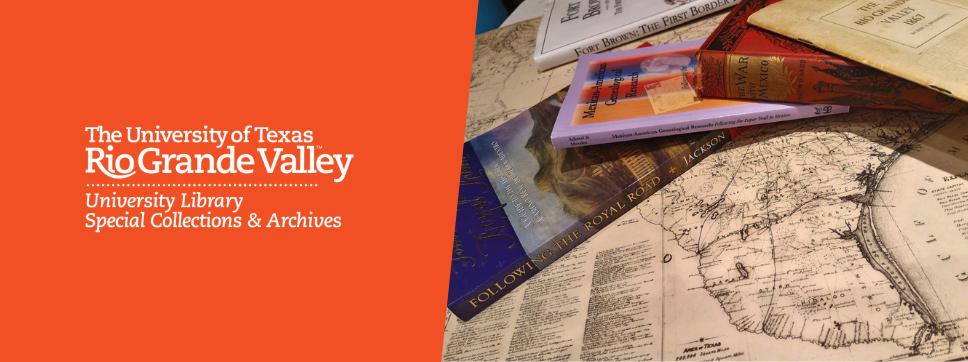Lower Rio Grande Valley Curated Material
-

The Cantú Family: a porción of Edinburg
University of Texas--Pan American. Community Historical Archaeology Project with Schools Program (CHAPS), Margaret E. Dorsey, Janarae Alaniz, Roland Silva, and Roseann Bacha-Garza
The Cantú family settled in Edinburg, Texas, in the early 1920s and have since developed a thriving produce and trucking business providing crops to markets in the Rio Grande Valley, Houston, and even up further north to the Midwestern states area. This report is the culmination of approximately 24 months of research, fieldwork, and revisions conducted beginning in the Fall of 2012 from a class of undergraduate and graduate students at the University of Texas-Pan American titled “Rediscovering the Rio Grande Valley” under the direction of a multidisciplinary faculty of anthropologists, archaeologists, biologists, geographers, geologists, and historians. This is the story of one of the many Mexican American farming families that settled in the Rio Grande region after escaping Mexico’s Revolution (1910-1920).
-

The centennial celebration of the organization of Hidalgo County in Texas, December 7-13, 1952 Official Program
Hidalgo County Centennial Corp. and Times Pub. Co.
Black and white booklet promoting the centennial of Hidalgo County.
-

The Ghosts of Mier: Violence in a Mexican Frontier Community during the Nineteenth Century
Jamie Starling
On April 23, 1852, Ramona de la Peña became a widow for the second time when she buried Eusebio García at the Inmaculada Concepción Parish of Ciudad Mier, Tamaulipas. The priest who conducted the burial, Father José Luis Gonzaga García, had ministered to her family over the previous thirteen years and baptized five of the couple’s children. He christened their youngest, Gregorio, about a year earlier. On the day of the burial, the priest wrote a sacramental record that described Eusebio García’s death “in the hands of the Americans” (en manos de los americanos). He was one of eight Mexicans who died in a conflict that swept across adjacent areas of Texas in the early months of 1852 and among the over two hundred killings recorded in Mier between the Mexican War of Independence (1810–1821) and the French Intervention (1862–1867).
Mier and its neighboring towns date to the foundation of the Nuevo Santander colony under José de Escandón from 1749 to 1767. Over the following century, other frontiers overlapped with that of Spanish- Mexican colonists in the region. Plains Indians such as the Comanche, Lipan Apache, and Kiowa raided Mier’s surrounding ranches, especially after Mexican independence in 1821. At the same time, Anglo settlers and African American slaves reached Texas, and by the 1840s, American expansionists set their sights on Mier and its surroundings. The lower Rio Grande became a multifaceted contact zone that simultaneously witnessed lucrative trade, cultural exchange, intermarriage, and harrowing acts of brutality. The records of the Immaculate Conception Parish of Mier contain many accounts that attest to the contact and conflict that marked this frontier.
-

The Grapefruit Special vol.1 no.3
Julia Cameron Montgomery
A short booklet dedicated to the Golden Grapefruit of the Rio Grande Valley. The booklet describes how the Valley is a great place for agriculture. It also addresses other areas such as fishing and hunting, and women's activities.
-

The Legacy of the Underground Railroad in Texas - The Webber and Jackson Families of Hidalgo County
The University of Texas Rio Grande Valley. Community Historical Archaeology Project with Schools Program (CHAPS)
While most of the pathways of the Underground Railroad to lead north into Canada, there was also movement along pathways through Texas and into Mexico. Lured by the fact that slavery was abolished in Mexico, enslaved peoples were able to achieve freedom by traversing Texas, slipping over the Rio Grande, and settling in colonies throughout northern Mexico. As Mexico had abolished slavery, the path to freedom for many African Americans was through Texas. With the re-enactment of the Fugitive Slave Act, the Dred Scott Decision, and anti-miscegenation laws, families of mixed races felt the crescendo of animosity and hate throughout the southern states. This film tells the unique story of two bi-racial families, the Webbers and the Jacksons, who migrated to the newly established natural and international border and established their identity through immediate assimilation into Tejano culture. The unique characters within these mixed race families sought a new beginning as frontier pioneers along the natural border known as the Rio Grande. Both families were led by white men, John Webber and Nathaniel Jackson, and their strong, determined, and brave African American wives, Silvia Hector Webber and Matilda Hicks Jackson respectively. The willingness of these families to help those in need speaks largely to the current regional cultural legacy of helping others. These families displayed a strong commitment to underserved populations because they were welcoming and willing to assist others. Their participation in what we refer to as Underground Railroad-like activity is what puts these families on the national and international map. Today's descendants of the Jackson and Webber families have been instrumental to this research. We would like to thank each and every one of them who have assisted in this process along the way.
-

The Lower Rio Grande Valley of Texas
Missouri Pacific Railroad Company
This booklet contains advertisement for the Rio Grande Valley that highlights the various commercial, agricultural, and recreational prospects available. It chronicles the impact of the railroad's arrival and how it stimulated progress in areas such as irrigation, fishing, hunting, beaches, lodging, cities, residences, farming, and crops like cotton. Additionally, it touches on the importance of religion and high-quality education, and the expansion of the railroad network to enhance accessibility.
-

The Lure of the Rio Grande
Brownsville Chamber of Commerce
An early (ca1930) silent film production heralding the attractions of life in the Lower Rio Grande Valley. This production served the purpose of attracting potential investors and boosting the local economy in Brownsville, Texas and the Lower Rio Grande Valley. "Foreword: Like Ponce de Leon and La Sale of old, like Jason and the Golden Fleece - ,mankind still takes the trail to find the Rainbow's End and the land of the ideal. (...) now, thousands of winter-weary northerners and Chicagoans in particular, are (...) to the new mecca of the southland, the extreme southern tip of the United States where Uncle Sam meets Mexico - the Valley of the Rio Grande. "
-

“The Most Turbulent and Most Traumatic Years in Recent Mexican-American History”: Police Violence and the Civil Rights Struggle in 1970s Texas
Brent M. S. Campney
This study builds upon a flurry of scholarship focused on racist (primarily mob) violence against Mexican Americans—indeed, persons of Mexican descent broadly—in the American Southwest since 1848. Some scholars have examined the history of mob violence, particularly lynching, against persons of Mexican descent from 1848 to 1928 in California, Arizona, New Mexico, and Colorado. Although these southwestern states [End Page 34] had their share of such violence, historians William D. Carrigan and Clive Webb concluded that Texas was singular: Anglo Texans “were almost universally regarded as possessing the greatest animosity toward Mexicans.” Others have focused on mob and police violence. They have addressed in detail the massacre of ethnic Mexicans in the lower Rio Grande Valley in 1915 by mobs and Texas Rangers. In chronicling this massacre, they have provided an important service: identifying the centrality of police violence in Mexican American history. Until this essay, however, scholars have not addressed comprehensively racist violence or local police violence against Mexican Americans in the Southwest generally or in Texas particularly in the period since the Great Depression.
-

The Rio Grande Valley in the time of the pandemic: community responses to COVID-19
The University of Texas Rio Grande Valley. Community Historical Archaeology Project with Schools Program (CHAPS), Selena Alvarado, Luis Barreda, David Cantu, Melinda Ann Cantu, Melanie Castro, Colleen A. DeGuzman, Jose L. Garcia III, Fatima Garza, Valeria Garza, and Roseann Bacha-Garza
The research for this report was conducted as a result of an interdisciplinary course of Anthropology and History at the University of Texas Rio Grande Valley during the Fall semester of 2020. During the pandemic, we shifted from conducting this course through group projects and students instead produced individual primary source research. This occurred simultaneously as students and the rest of the populace sought to make sense of their experiences in the very changed framework of the COVID-19 world. The effort epitomizes the importance of recording history in real time, especially within a region that was as so negatively impacted by the coronavirus as the Rio Grande Valley of Texas was in the Summer of 2020.
Accompanying presentation: https://youtu.be/SOrorZvu46o
-

The treasure land of the lower Rio Grande
Baker Bros. Engravers
Black and white promotional booklet describing the Lower Rio Grande Valley. It covers everything that the Lower Rio Grande Valley has to offer, and how it was growing in all sectors.
-

Treasures of the Rio Grande delta
John Bax and Gorgas Science Foundation, Inc.
John Bax provides cinematography for an exhaustive study of the Lower Rio Grande Valley.
Long known as the River of Destiny, the Rio Grande has been the focus of both conflict and peace between Mexico and the United States. Although rich in history, the river’s delta also supports a rich legacy of natural history. Twisting and turning from the Chihuahuan Woodlands to the Gulf of Mexico, the last 250 miles of this great river form a rich delta, a transition zone between the semiarid tropics and the temperate north. Since 1900, most of the delta’s native vegetation has been lost, but many small islands of endangered habitat survive at the edge of farms and cities. These islands harbor an incredible number of endangered or threatened species. Some are known only from the delta or reach their northern limits here.
-

Volume 01 – En palabras de nuestra gente
Manuel F. Medrano, Antonio Medrano, Oliver Brenner, and Narcisco Martinez
Antonia Medrano from Brownsville, Oliver Brenner from Port Isabel and Narciso Martinez from La Paloma speak about their lives, the 1933 hurricane and the importance of a formal education.
-

Yearbook of the Lower Rio Grande Valley of Texas and Northern Mexico, 1961
Mabel Collier Eppright and Gladys Collier Hooper
A Welcome from the Governor of Texas / Price Daniel -- "The Valley-A Metropolitan Area," / Jack H. Drake -- Highlights of 1960-Facts, Figures and Events -- Letters to the Editors -- Did You Know? Unusual Facts in the Valley -- "Agriculture," / Stanley B. Crockett -- "Marrs Early Orange," / Mabel C. Eppright -- Agriculture-Citrus, Vegetables, Cotton -- Let's Go to Mexico -- Fascinating Phases of Valley Life -- "Valley Variety," / Bill Watts -- "Cotton," / W. R. Cowley -- "Cotton's Problems in a Changing Agricultural Economy," / R. D. Lewis.
-

Yet more studies in Rio Grande Valley history
Milo Kearney, Anthony K. Knopp, Antonio Zavaleta, and Thomas Daniel Knight
Frontera, a poem / Elvira Ardalani -- Strasbourg, Alsace, and Brownsville, Texas : ideal sister cities / Milo Kearney -- La concepción de la identidad fronteriza en Jovita Gonzalez y Adela Sloss de Vento / Laura Garza -- Cuando se fundo Matamoros? / Andres F. Cuellar -- The formation and early development of the Llano Grande / Maria Vallejo -- Doño Rosa Maria Hinojosa de Balli and her family : a lower Rio Grande Valley family in an Atlantic perspective / Thomas Daniel Knight -- Clarksville : a forgotten community on the Rio Grande / Jim Mills -- The last battle of the Civil War / Norman Rozeff -- The Spanish Influenza epidemic in Brownsville, Texas, and Matamoros, Tamaulipas, Mexico / Jorge Hernandez -- El Puerto de Brownsville newspaper: the voice of the Mexican-American Community / Cipriano Cardenas -- McAllen’s key contribution to the U.S. Cuban history / Oscar Sordo -- La amenaza de la Encefalitis y una visita presidencia a Matamoros en 1971 / Rosaura Alicia Davila -- Oscar Casares, frontera writer : a little more hope, a little less fear / Manuel Medrano -- Immigrant child, a poem / James Brandenburg -- Undocumented immigrants narratives : a view from the banks of the Lower Rio Grande / John A. Cook -- The tragedy of unaccompanied child immigrants to the U.S.-Mexico border 2014 / Antonio Noe Zavaleta Reid and Mitchell A. Kaplan -- Young, wild, and free : narratives de jóvenes migrantes Mexicanos detenidos en el Valle de Texas / Oscar Misael Hernandez-Hernandez -- The recent violence in Matamoros : are we living next to a war zone? / Anonymous -- The humorous side of Brownsville Police work / Ruben Garcia and Anthony Knopp -- Bilingual college education at UTB : improvement student success in the Rio Grande Valley / Guadalupe Correa-Cabrera and Oralia de los Reyes -- The deaf community of Brownsville : site of controversy over language and identity / Mimosa Stephenson -- Antepasados, a poem / Janie Alonso.


